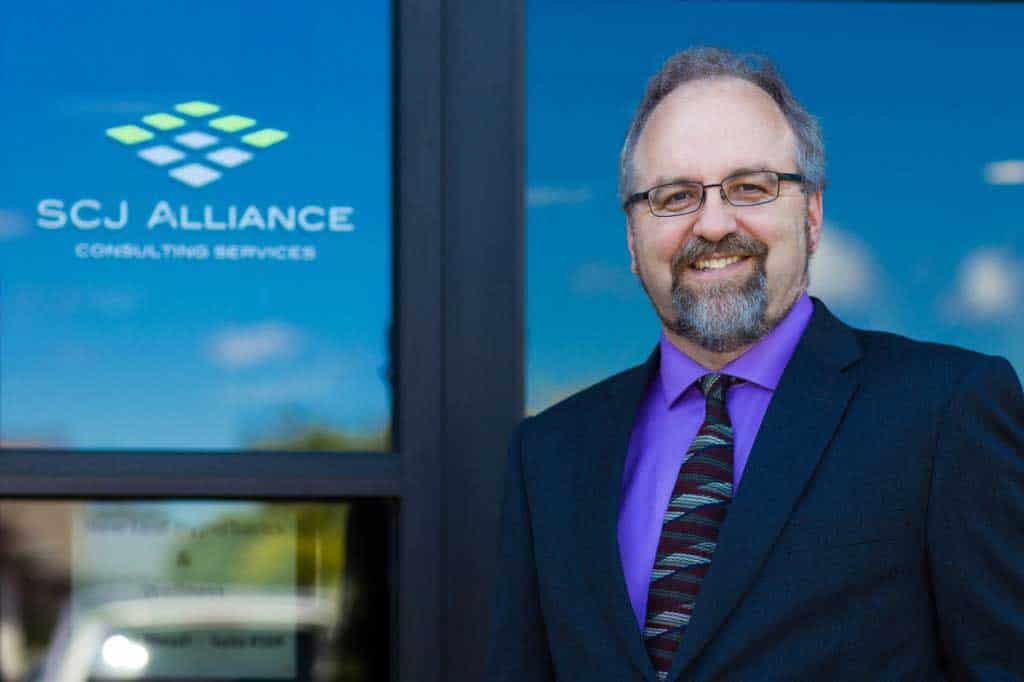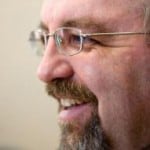I’m here with Perry Shea, PE, President of SCJ Alliance in Lacey, Washington. SCJ Alliance was a winner of the Tacoma Business Examiner’s 2016 Top Places to Work. We’re talking about leadership, company culture and employee engagement.
Note: This article is from my series of interviews of local leaders who deliberately build and nurture strong company cultures. You can find links to my other Local Heroes stories at the end of this article.
Lauren: Tell me about SCJ Alliance.
Perry: About 10 years ago, Jean Carr, Bob Jewell and I started SCJ Alliance. We came from a larger company of 300 to 400 employees. We decided to leave and create our own vision for our own company, centered around people. We had really good clients and the economy was strong in 2006. We had some clients that followed us and we had other employees that came along. At the time, our work primarily focused on the private sector. That was the beginning of our company.
Since then we’ve evolved and have a pretty diversified business model, both public and private sectors. For example, on the public side, we do a lot of transportation design like freeways and interchanges, highways, roundabouts, signals, lots of street planning. On the civil engineering side, it’s dealing with site development, grading, water, sewer and utility type infrastructure. We have some corporate clients throughout the western United States. Our planning side is very strong as well. We do environmental studies, permitting, environmental assessments, and landscape architecture. As we grew, my partners and I started developing a leadership team and that took off. We set the foundation in place and now we’re a little over 80 employees and we’ve got five offices, most of them in Washington State and one in Denver, Colorado.
How big is the leadership team?
The leadership team is growing. Right now I’ll say it’s about 12 and that includes both the senior principals, partners of the firm as well as what we call business group leaders, who are practice builders that lead those specific areas of expertise. We are very targeted and specific around the clients that we choose to work for and the types of services that we offer. We’re definitely not a commodity-type company. We really promote value-based decisions and solutions, not commodity-based. I think we’ve held true to that premise, that core purpose of our firm. Our clients stay with us because they know we’re going to treat them fairly. We always come through for them and that builds loyalty.
It sounds like you had this core “WHY” or mission around building trust and relationships right from the beginning. Were there times where you strayed from that mission?
What was very interesting is from 2006 until 2008, things were just gang busters everywhere. As the economy softened in 2008, we decided to shift a lot of our focus from the private sector to the public sector which has now become 65% of our work. That created a diversified portfolio for us so we could ride the rough waves a little bit better. We had challenges in those times where we had to make choices about accepting some work, depending on the client. If that client didn’t match up to our core values, what we’re trying to do, then we had to make some tough decisions. You have to stay true to that because if you don’t, you don’t have a defined purpose. That was a little stressful because at that time, everybody needed the work. We grew and we invested significantly in our marketing, business development and our core branding, which set us up for when the economy started to recover, propelling us where we are now. So instead of regressing like a lot of companies who pulled back — reducing overhead and people that were considered ‘non-revenue generating staff’ — we brought in more people. We increased those types of skill sets so that we could increase our market share rather than regress, not letting the economy take control of us. We were really proactive rather than reactionary. I think that really helped then. Now when we have to make tough decisions about where to go in certain markets and what clients to work for, we make sure that every alliance is what we’re about. It’s a great recruiting tool because we can show folks and our employees what we do here matters. We treat people well.
That really came through on your Top Places to Work application.
Well, it really starts with the first conversation. When we have an interview, we don’t have six to eight questions asking someone to explain this or explain that. We’re having a conversation because in that conversation we have for an hour, hour and a half, we’re going get to know each other personally and see whether or not you’re a good fit culturally with the company by being a good listener, being interactive and attentive, and a little outgoing. We want people who can take a risk and are willing to step a little bit out of their comfort zone. We call that working “in the gray,” which is really important here because when you work in the gray, that’s where you find creativity. If you are not comfortable with that, then you’ll probably be better off going to work for a company that’s more of a commodity-based firm. It’s a little easier, more straightforward and you’re more comfortable in every decision you make. That’s definitely a paradigm shift, especially in an engineering company because that’s not normal. Engineers tend to be very literal. We’re trained to be linear thinkers, step 1 through step 10. While we do that, that’s not how we approach projects.
We built our culture on trust. In fact, we empower our employees to strive to do great things, to step out a little bit. We’re good listeners. There’s a whole art around how to listen and that’s one of the things that we really promote here as well. You’re not trained to do any of that when you go through your curriculum in college. You’re trained to be a thinker and problem solver. Here we’re training people to be look-and-listeners, communicators, to collaborate, to develop relationships. While we can teach all the technical elements of what we do here, it’s very difficult to teach the personal attributes that we think are significant, so we look for those. We have these interviews which are really kind of fun because the interviewee has no idea. We’re just having a conversation and when we’re done, they say, “Oh, that was interesting. That was fun.”
They get into a comfortable spot and we can see how they react and how they work. I think that’s really the first point—the first introduction, the first impression that means a lot.
Jean, Bob and I, within the first six months of starting the company, went through an exercise to determine our core values and those are the guiding principles of our firm. We give a copy to all our employees when they start. Then we talk about how you use them. It’s one thing to say what they are but the question is, how do you apply them in your daily work?
I’ve seen companies where when they’re done with their core value exercise, they’ve got a nice plaque on the wall. They never talk about it again. They have a beautiful set of core values and nobody adheres to them. It has to be an ongoing conversation to be meaningful.
Having that be part of your daily routine and in your practice from the top down really embodies our culture in the firm and I think that our staff recognizes that. Our challenge, since we’ve grown so fast, is making sure we maintain the culture. We’re working right now on how we can increase collaboration when we are in different places.
Especially with remote offices.
Yes, because they could feel isolated. They’re not around the kind of epicenter of the company, where everything’s happening even though we’re trying to grow those offices. So once a month, we do a really fun thing where we take an hour in which everybody comes together in a company-wide staff meeting via an interactive video conference. There are a few things around the business but what we are really doing is sharing what people are doing, both in the community as well as at work. It’s general information that everybody should share, listen to and hear about the company. Everybody can see each other and it’s a fun atmosphere. I tell you, they’re about 95% attended; that might be low. Nobody misses a staff meeting.
They actually look forward to this versus thinking, “here we go again.”
Right! Because it’s going to be something different every time. We change it up a little bit, about what we’re going to share, what we’re going to provide. And different folks from the company all have a role. So it’s meaningful to all staff that it’s not just Bob, Jean or Perry or one of the other executive team members of the company.
I always get asked by my clients about what’s the best way to find out if candidates are aligned with their company’s core values. For example, you just talked about how important it is to be collaborative at SCJ. How can you find out if someone is collaborative from an interview?
We do it in a couple ways. One of us will ask how, in your prior job, when you’re asked to do something or if you’re leading a team, how did you engage in conversation with your team members? What tactics do you use to bring out information and sharing of knowledge? How do you encourage others to participate in a dialogue? Things like that.
We ask questions that would not be a yes or no answer but a question that’s going to require that we have a conversation. If they’re able to expand on that and give examples and have good eye contact, they’ve got some really good strengths there. If it’s a real short answer after looking down on the ground, sometimes you can still find some really good nuggets. We do less talking, trying to get that person do more communication so we can see how they engage in their teams here because we expect and we foster an environment where everybody brings something to the party every day. We’re a learning organization and we learn something new every day, including myself. Communication is the fundamental, the most important thing in this company. Next would be our technical expertise. I think if you interviewed ten engineering firms, they would probably say technical expertise is number one.
When a new employee comes in, part of the orientation is a half hour to 45 minutes set aside that I have with each employee, and were often joined by other members of our senior leadership team. The whole reason for that is to have this conversation where we’re giving permission, regardless of the title or position we have in the company, that we’re all here to work together, we’re all here to help, and we’re all approachable, our doors are open. We invite and solicit input and we want that from everybody in the company.
So that happens the first week?
The first week. It’s really fun because folks that have come from other companies — there’s one person we hired last year who was at their prior firm two to three years and maybe set eyes on the president once. I told him, “Well, that’s not what we do here.”
How do you give people feedback on their performance?
We do have prescriptive times, and traditionally have gone through formal evaluation processes, but we’ve actually done something new this year. We’ve changed it up. Instead of having a performance review, we create a professional development plan with them and that has really motivated people. We’re rolling it out this month to the rest of the company and that’ll be really fun to see what comes out of that. We’ll talk about areas for improvement but it’s really targeted on their interests and desires. It’s about, “How can we help you succeed? How can we get you to the next level?” Or, “How can we help you just continue doing what you’re doing that you love doing?” We’re going to help them get there. Then throughout the year, the expectation is that our managers are going to coach and mentor them and give them feedback on how they’re doing and where to course correct.
I think that’s really smart because I think everybody wants and needs feedback, especially the younger generation. I don’t know how different they are than anybody else but they really crave it.
They love feedback. They love to know. They like to understand where they can move to. It’s about making time for that.
And I think they want to know that they’re part of something bigger. I think everybody does but I think it’s more pronounced in that generation. I think companies that are clearer that they are not just building roads or making things, it’s that you’re a part of something bigger here, will attract and keep the best people.
Right. Why we do we do what we do is that we’re trying to make communities better. We’re stewards. We focus on a lot of smaller communities because they have more needs that I think we can offer solutions for. So while the outcome is a product, what that product does is really the foundation of our company making a difference. I think that’s what people get excited about.
What we try to keep in mind, whether it’s a private sector client or a public client, is what are your objectives outside of just turning dirt and building something? What else are you trying to achieve with this? How can we get you there? And you’ll find that most of the time, that question’s not asked. What’s your desired outcome in the end? I love that question because it provides so much insight and I think it’s not asked enough.
How do you identify potential leaders from outside the company?
The last three leaders who were brought in to manage some of our big business lines we had relationships with in their prior companies. We got to work with them and to really understand how they work. Then at the right time, it became an easy, easy conversation.
You’re out there scouting all the time.
Exactly right. We’re interesting that way because what we found, especially at that level, is that it’s very rare that we bring somebody in that we don’t have a connection with. It’s too risky for us. We’re always out recruiting, sensing, and at the right time we have a conversation that goes, “We think you can do some really wonderful things here that could look like this.” It usually takes a couple of something I call “touches” and then, you know, all of a sudden you get a new colleague.
Kind of like dating.
It is! It is like dating. We do not do a hard sell. So now we have an awesome leadership team with all the characteristics that I talked about: the ability to communicate, with very similar philosophies and core values around how they treat people and how they respect the communities. They all are civically involved, which is also important here. You need to give back and what’s fun is we don’t need to ask people to do that. It’s like they want to do it. It’s just part of our DNA and maybe because the people we find are already set up that way. We have a lot of folks who serve on boards and commissions for non-profits and civic organizations and it’s rewarding for them. I know it’s good for the company too but we support that because we care about the communities we work in. We want to make sure that everybody has an opportunity to do it.
Going back to the beginning of our conversation, you shared when you went off and launched this company, you invested in people and created systems and structures, including a leadership team. How big a part of the leadership team’s growth has been essential to this company’s growth?
I think it’s been a huge factor because when we were smaller, a lot of the responsibility fell on a few people’s shoulders to do everything. So when we started to build the leadership team, we empowered them and gave them the opportunity to manage some of the key clients of the firm, which was tough for me. I had to give up some clients. But I knew that was the best for the next generation and our company’s success
And, ultimately, for the clients.
It was. And they’re happy. And that transition is worth it because the leadership team has been able to grow professionally. What’s happened since is exponential. When you give them the tools and the trust, you know they’re set to go out there and manage the affairs and you don’t have to worry or micromanage. It creates a catalyst. They work so well together that one business group leader could win a project that helps basically three of the other business lines. So they’re really a close team. From 2012 to where we are now the company’s doubled in size. A lot of that has been because our leadership team has grown but also they’ve been able to develop their lieutenant structure to help them. It’s really like building a tree, like a corporate tree is being built.
People want to grow their skills and they want to grow personally and I think organizations that allow, give people the opportunity to do so are really attractive to people. Three to five years from now, what does SCJ look like?
It’s going to be really cool whatever it is! We just finished a five-year strategic plan that gives us a road map. We’re probably going to be bigger. It means more geographic offices for us but if we grow, really grow, which I believe we will, it’s for the right reasons. It’s not growing for the numbers, it’s growing because there’s a need and our leadership team is in place, kicking butt. And they have clients to serve in geographic areas in which we can be pretty competitive. Being a growing company helps everybody. We talk about that a lot. We’ve just added 40 people in two and a half years. This growth is because we set ourselves up for it to occur.
Top people are always looking for an opportunity to grow.
I think from experience that puts pressure on the top leadership. How do I make sure that people are always feeling like they’ve got that opportunity to grow and that they’re learning more? It’s a lot of work. You can’t be complacent.





